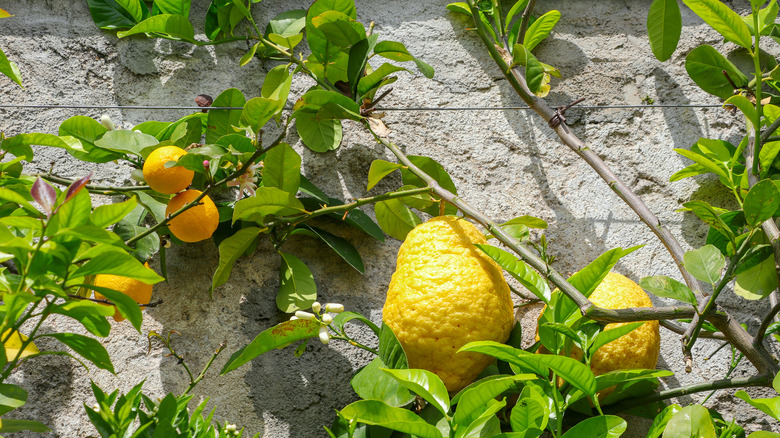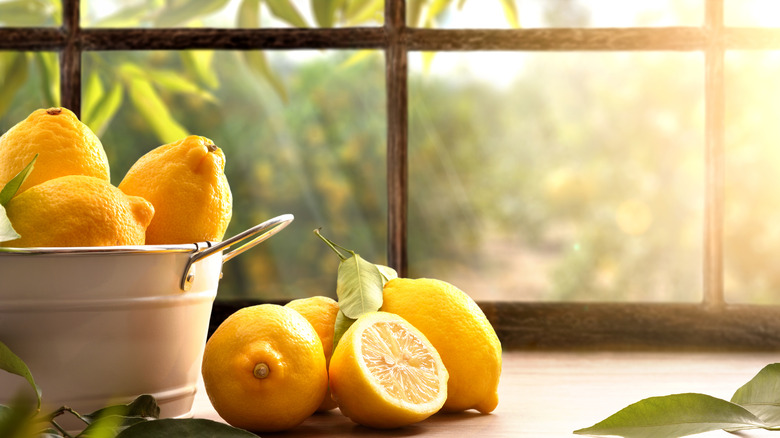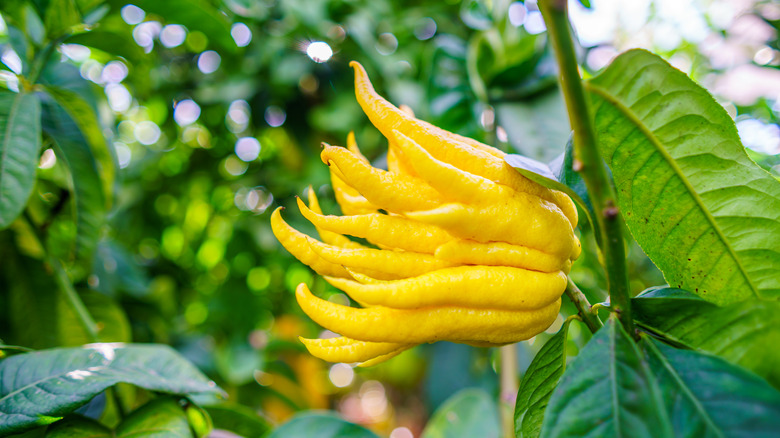Lemon Vs Citron: What's The Difference?
The citrus family tree bears fruit with complicated and sometimes unexpected relationships. Citrus is old, according to Atlas Obscura, probably about five or six million years old, and the citrus fruits we enjoy are related to three species: the citron, the pomelo, and the mandarin. Apeel Sciences explains that citrus plants cross-pollinate easily, which is why we have so many different citrus species and varieties among those species.
Leafy Place says there are more than a hundred varieties, so what makes one citrus? Apeel Sciences explains that all citrus fruits are hesperidium, which means they're berries with leathery skins. There's a pericarp, or a peel, that covers the fruit, and each fruit consists of the zest (outer layer), the pith (middle layer), and pulp and seeds in the center. All citrus fruits are full of ascorbic acid, also known as vitamin C. Exploring the differences between kinds of citrus fruits opens up fresh, zingy options in the kitchen, and understanding their properties can help you know when to use each variety. Given that some citrons look fairly similar to lemons, is there a big difference between them, or are they easily interchangeable?
Lemons are versatile and make a great substitute in recipes
According to All Recipes, a lemon is a hybrid, a cross between a citron and a bitter orange, which The Spruce Eats explains is a hybrid of pomelo and mandarin. The lemon, then, is a hybrid-hybrid, one that is related to all three of the original citrus fruits. Lemons are exceedingly versatile and valued for their unique properties – the zest adds a sunny, bright flavor to everything from marinades to muffins, and the juice adds lively acidity that helps balance salt and sweetness in a host of dishes.
Both homemade mayonnaise and hollandaise sauce, for example, which are emulsions of oil or butter and egg yolk, rely on lemon juice for the acidity that helps stabilize the mixture, according to Inspired Taste. Vinegar can be substituted for lemon juice, but lemons contribute the necessary acidity and a delicious flavor. If your recipe calls for buttermilk and you don't want to make another trip to the grocery store, lemon juice added to milk gives you the same tangy qualities in just a minute or two (via Healthline). Lemons play a host of roles in the kitchen, but they're distinctly different from citrons.
Citrons have bumpier skin, yield little juice, and are candied
Citrons aren't as common in the U.S., though they're the progenitor of other familiar citrus fruits. Brittanica explains that most citrons are grown in Mediterranean countries and in the West Indies, and Leafy Place says citrons originated in India. They're relatively large; some varieties of citron can grow up to 11.5 feet in height. According to Kitchen Substitute, some varieties of citron can sometimes be mistaken for lemon because of their similar color, though citrons usually have bumpier skin.
And on the inside, they're a whole different ballgame. Citrons have a very thick rind and pith, according to Serious Eats, and very little flesh or pulp, meaning they don't yield much in the way of juice. In addition, the juice most citron varieties produce is exceedingly bitter. Instead, Painless Cooking recommends that citrons be candied, preserved, or used to infuse syrup for cocktails. While citron zest can certainly be used in place of that of a lemon, that may be the only feature that can be used. Two of the most interesting varieties of citron are the Etrog citron, most notable for its use in the Jewish holiday of Sukkot, and the Buddha's Hand citron, which looks like a cluster of gnarled yellow fingers (via Specialty Produce).


